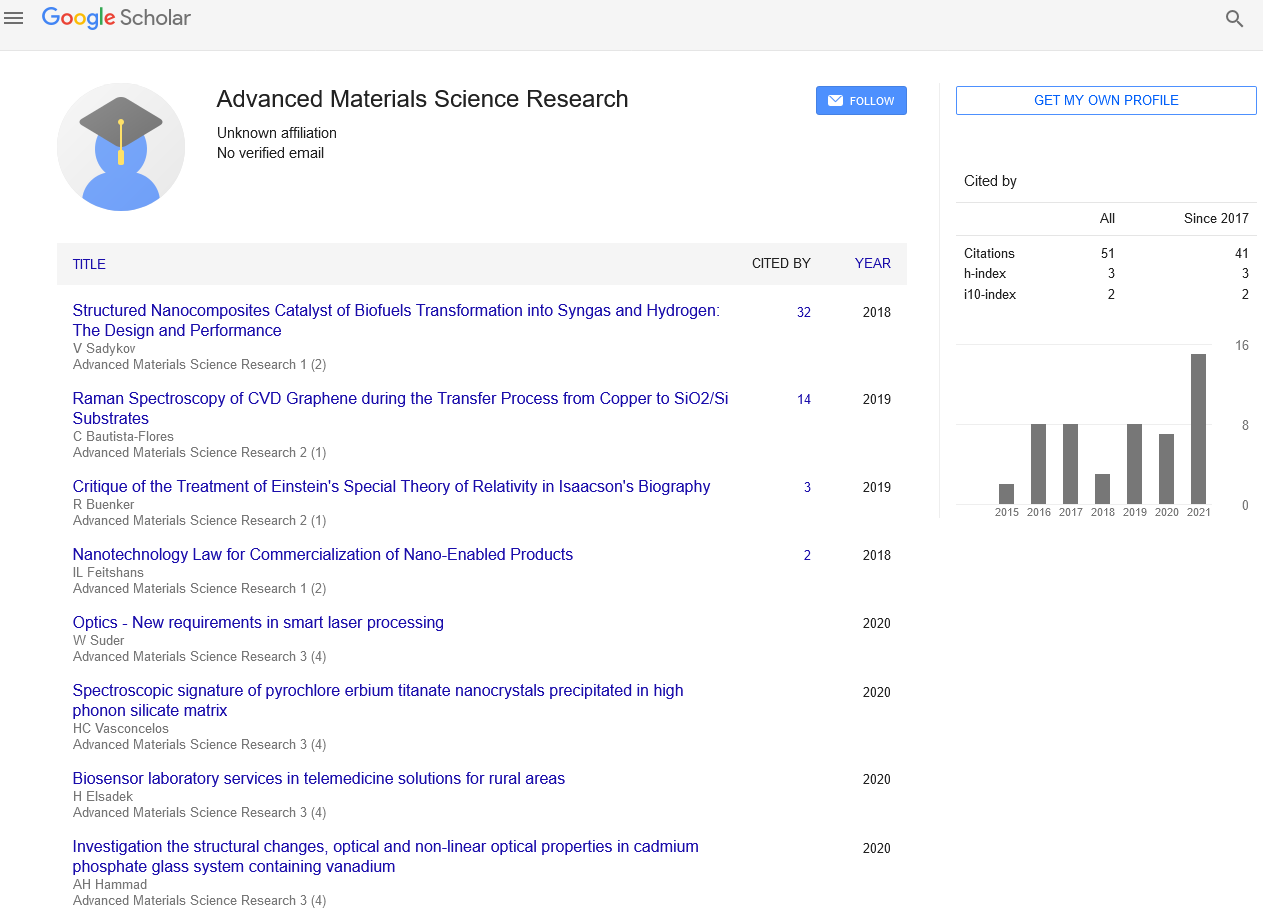Editorial - Advanced Materials Science Research (2023) Volume 6, Issue 4
Unravelling the Marvels of Magnetic Materials from Nature's Secrets to Technological
Mohn Gupta*
Department of Applied Mechanics, Indian Institute of Technology Madras, India
Department of Applied Mechanics, Indian Institute of Technology Madras, India
E-mail: Mohngupta4@gmail.com
Received: 01-Aug-2023, Manuscript No. AAAMSR-23-108057; Editor assigned: 03-Aug-2023, Pre-QC No. AAAMSR-23-108057 (PQ); Reviewed: 17-Aug-2023, QC No. AAAMSR-23-108057; Revised: 22-Aug-2023, Manuscript No. AAAMSR-23-108057 (R); Published: 29-Aug-2023; DOI: 10.37532/ aaasmr.2023.6(4).61-63
Abstract
Magnetic materials have been at the forefront of scientific research and technological advancements for decades due to their unique ability to generate and respond to magnetic fields. This abstract provides an overview of the key aspects of magnetic materials, including their fundamental properties, diverse applications, and potential future developments. The abstract begins by introducing the fundamental principles of magnetism and the classification of magnetic materials based on their magnetic behavior. This includes a discussion of ferromagnetic, antiferromagnetic, ferromagnetic, and paramagnetic materials, elucidating the underlying atomic and electronic interactions responsible for their magnetic properties. The abstract delves into the applications of magnetic materials across various industries. Magnetic materials play a crucial role in electrical engineering, enabling the creation of transformers, motors, and generators. They are also instrumental in data storage devices, such as hard drives and magnetic tapes. In the biomedical field, magnetic materials find applications in magnetic resonance imaging (MRI) and targeted drug delivery systems. Furthermore, the use of magnetic nanoparticles in environmental remediation and pollution control is highlighted, showcasing their potential for sustainable practices.
Keywords
Magnetic materials • Antiferromagnetic • Paramagnetic materials • Ferromagnetic • Bio-medical field
Introduction
Magnetic materials have fascinated humankind for centuries, captivating both scientists and inventors with their peculiar properties. From the enigmatic compass needle that guided ancient sailors across uncharted waters to the cutting-edge technologies powering our modern world, these materials have played a pivotal role in shaping history. In this article, we delve into the captivating world of magnetic materials, exploring their origins, properties, and revolutionary applications. The explores recent advancements and emerging trends in magnetic materials research [1]. It touches upon cutting-edge materials, such as rare-earth-free magnets, which offer sustainable alternatives to traditional magnets while maintaining high-performance characteristics. Additionally, the abstract discusses the exploration of new magnetic phenomena, such as spintronics, magnonics, and skyrmionics, and their potential impact on future technologies. Magnetic materials continue to be an essential component of modern technology, influencing various aspects of our lives and driving innovation across industries. Their unique properties and versatile applications make them indispensable in the pursuit of more efficient, sustainable, and advanced technologies. As researchers continue to unveil novel phenomena and materials, the possibilities for magnetic materials in shaping the future are boundless [2, 3].
Understanding magnetic materials
Magnetic materials owe their unique behavior to the alignment of their atoms' magnetic moments, giving rise to what is known as magnetism. The two most common types of magnetism are ferromagnetism and paramagnetism [4].
Ferromagnetism: This property is exhibited by materials like iron, nickel, and cobalt, where neighboring atoms align their magnetic moments in the same direction, creating a strong, persistent magnetic field. Ferromagnetic materials are capable of retaining a significant level of magnetization even after an external magnetic field is removed, making them ideal for various applications, including magnetic storage and electric motors [5].
Paramagnetism: Unlike ferromagnetic materials, paramagnetic materials have randomly oriented magnetic moments. When subjected to an external magnetic field, these moments align in the direction of the field, creating a weak magnetic response. Paramagnetic materials lose their magnetism once the external field is removed. Examples of paramagnetic materials include aluminum and platinum.
Beyond these primary classifications, there are also antiferromagnetic and ferrimagnetic materials, each with unique magnetic properties and potential applications.
Applications of magnetic materials
The diverse properties of magnetic materials have led to their widespread use in various industries and technologies. Some of the most prominent applications include:
Magnetic storage: Magnetic materials are at the heart of data storage technologies like hard disk drives (HDDs) and magnetic tapes. The ability to store data in binary form using magnetic fields has revolutionized the way information is stored and accessed [6].
Electric motors and generators: The conversion of electrical energy into mechanical energy and vice versa is made possible through the interaction of magnetic fields in electric motors and generators. This has countless applications, from powering household appliances to driving industrial machinery.
Magnetic resonance imaging (MRI): In the medical field, magnetic materials find application in MRI machines, which create detailed images of the internal structures of the human body. The precise control of magnetic fields is essential for producing accurate and informative images.
Sensors: Magnetic sensors, such as Hall-effect sensors, are widely used in automotive and electronic devices to measure current, position, and speed. They play a crucial role in enabling safety features and enhancing performance in modern vehicles [7].
Magnetic separation: Magnetic materials are used in various industrial processes to separate magnetic substances from non-magnetic ones, such as in mineral processing, waste recycling, and water purification.
Cutting-edge developments
As research and technology continue to advance, new frontiers are being explored in the world of magnetic materials. Scientists are developing materials with enhanced properties, seeking to optimize their behavior for specific applications. For instance:
Spintronics
High-temperature superconductors
Magnetic nanoparticles: Researchers are investigating magnetic materials that can exhibit superconductivity at higher temperatures. Achieving superconductivity at less extreme conditions would revolutionize power transmission and energy storage [8].
This emerging field focuses on utilizing the spin of electrons in magnetic materials to develop ultra-fast and low-power electronic devices. Spintronics promises significant advancements in computing and information processing [9,10].
Nano scale magnetic materials are being explored for targeted drug delivery in medicine, environmental remediation, and enhanced data storage capabilities.
Conclusion
The study and application of magnetic materials have come a long way since their initial discovery. From ancient navigational tools to cutting-edge technologies, magnetic materials have become indispensable components of our modern world. As research progresses, new breakthroughs will undoubtedly lead to further advancements, unlocking more of nature's secrets and expanding the horizons of human innovation. The future of magnetic materials holds exciting possibilities, promising to shape the technologies and industries of tomorrow.
References
- Ratnamani MPC, Zhang X, Wang H. A Comprehensive Assessment on the Pivotal Role of Hydrogels in Scaffold-Based Bioprinting. Gels .8, 239(2022).
- Leszek A, Danikiewicz D, Lech B et al. Effect of biomedical materials in the implementation of a long and healthy life policy.Processes9, 865(2021).
- Yiwei L, Liu BF, Zhang X. Wettability-patterned microchip for emerging biomedical materials and technologies.Mater Today. 51, 273-293(2021).
- Ghomi R, Nourbakhsh N, Kenari MA et al. Collagen‐based biomaterials for biomedical applications.JBiomedMaterResPart BAppl Biomater J. 12, 1986-1999(2021).
- Spiegel CA, Hippler M, Münchinger A et al. 4D Printing at the Microscale. Adv Funct Mater.2019, 30, 1907615
- Saraswat S, Yadava GS. An overview on reliability, availability, maintainability and supportability (RAMS) engineering. Int J Qual Reliab Manag. 25, 330–344(2008).
- Pugliese H, Raffaele S, Regondi S. Artificial intelligence-empowered 3D and 4D printing technologies toward smarter biomedical materials and approaches.Polymers.14, 2794(2022).
- Francis K. Biological evaluation of preceramic organosilicon polymers for various healthcare and biomedical engineering applications: A review.J Biomed Mater Res - B Appl Biomater.109,744-764(2021).
- Zhou W, Qiao Z, Huang J et al. 4D-Printed Dynamic Materials in Biomedical Applications: Chemistry, Challenges, and Their Future Perspectives in the Clinical Sector. J Med Chem. 63, 8003–8024(2020).
- Ziheng L. Computational discovery of energy materials in the era of big data and machine learning: a critical review. Materials Reports Energy.1, 100047(2021).
Indexed at, Google Scholar, Crossref
Indexed at, Google Scholar, Crossref
Indexed at, Google Scholar, Crossref
Indexed at, Google Scholar, Crossref
Indexed at, Google Scholar, Crossref
Indexed at, Google Scholar, Crossref
Indexed at, Google Scholar, Crossref
Indexed at, Google Scholar, Crossref
Indexed at, Google Scholar, Crossref

